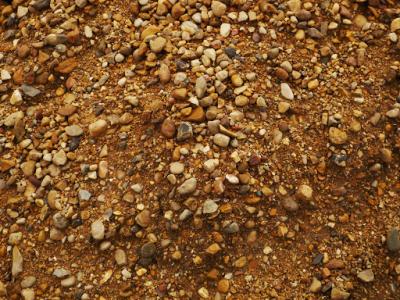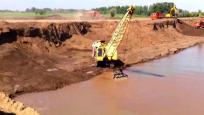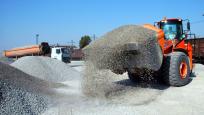Supply of sand and gravel mix
Category:
#2547
Description
Sand-gravel mixture is an inorganic loose non–metallic building material. It is used in various fields of the economy, and its main application is in construction work.
From the point of view of operational characteristics, products with a homogeneous structure, dominated by gravel granules, have a balanced weight-volume ratio, and contain fewer weak grains and foreign inclusions per cubic meter, are considered the best.
Composition and technical characteristics
The sand-gravel mixture is produced in accordance with the requirements of GOST 23735-2014, 8267-93, 8736-14. Mining is carried out by the quarry method – in open areas and from the bottom of reservoirs.
At the same time, it is possible to use a technology that removes the upper sandy-clay soil, below which there are layers of gravel-sand mixtures. Another option does not involve stripping surface rocks: natural components are removed from above – along the banks of rivers or lakes.
According to where it is mined, the products have the appropriate characteristics and qualify as
gorno-ravine: includes grains of various sizes, the shape of which is angular, with sharp edges; inclusions of the parent rock are observed, in the deposits of which the deposit is located, as well as organic matter (clay, etc.);
marine: gravel granules are rounded, rounded, mostly small;
lake-river: particles of rounded, rounded, uniform grain configuration are combined with organic impurities.
The less mountainous the terrain where mining is carried out, the greater the proportion of grains of sand and the smaller their diameter. Gravel is also smaller in diameter. This is due to the fact that in the process of formation, the granules of these rocks were washed out and transported by water further from the mountainous area. And since water flows are capable of carrying small objects, the fraction of the resulting sediments is shallower than where the terrain is mountainous. The closer the deposit is to the sources of the reservoirs, the greater the size of the stones and grains of sand.
According to the requirements of state standards, the following indicators are taken into account when determining quality parameters.
The sizes of gravel grains range from 10 to 70 millimeters. Pulverized and clay particles should not exceed a volume of five percent. And the clay content in the form of lumps is allowed at a level not exceeding one percent of the total mass of the natural product. In the enriched form, no more than 3% of clay inclusions and a maximum of 0.5% of lumpy clay.
Depending on the size of the gravel granules, the fraction of the product is determined. For example, if the grain diameter is no more than 8 millimeters, the fraction designation will look like 0-8 mm.
The mineral composition of the sand component and the size of the grains of sand are taken into account. The level of resistance to low temperatures and temperature fluctuations plays an important role.
The list of quality indicators also includes the number of components: this is reflected in how strong the buildings will be built on the basis in which such a product is present. For example, there may be less clay in such natural deposits, or it may be practically absent.
The radioactivity of the product is also taken into account. This parameter depends on the location where the mining was carried out.
Kinds
Depending on the proportion of gravel in the total volume, the product is divided into two varieties.
Natural GHG is not subjected to additional processing after extraction. It is delivered to the customer in the same form in which it was extracted. A distinctive feature is the proportion of gravel grains in the volume from 10 to 90 percent. The particle sizes are 5-70 millimeters. They are mixed with clay, quartz and other ingredients. The quality indicators of the gravel component are prescribed by the state standard 8267-93, which regulates the characteristics of crushed stone and gravel particles consisting of high-density rocks. The quality of the sand must meet the requirements of the state standard 8736-14, which specifies the parameters of the building component. The product is allowed to contain no more than 20 percent of the particles that pass through the sieve with mesh No. 014.
The enriched products represent an additionally processed composition. To improve the technical characteristics, the proportion of gravel or sand particles increases or decreases. Grains of sand and other components passing through the No. 014 sieve should not be more than ten percent. Inclusions in the form of dust, boulders, and clay are also removed. Crushed gravel and sand, or one of these components, can be introduced. Crushed stone helps to increase the adhesion of the filler to the mortar when preparing cement or concrete, which ultimately increases the strength of the mortar.
The diameter of gravel pellets should not be less than 20 and more than 40 millimeters. In rare situations, it is allowed to exceed it – up to 70 millimeters.
The content of gravel grains affects which category a product belongs to.:
The first one is 15-15%;
The second one is 25-35%;
The third is 35-50%;
The fourth is 50-65%;
The fifth is 65-75%.
Application areas
These products are used
during the laying of foundations, during the backfilling of the excavation, the arrangement of the "cushion" for the foundation blocks;
in the production of concrete as a filler;
for filling the lower layers of the road "pie", on which the coating is laid;
When creating embankments, it acts as a drainage layer.;
in the arrangement of playgrounds;
in landscape design – for land reclamation and landscaping;
in other types of construction work;
when laying pipeline systems.
The choice of a specific type and class of product depends on the purposes for which it is planned to be used. Thus, enriched products with a high and medium content of gravel grains are used in the creation of the upper layer of roads of the fourth and fifth categories of local importance, as well as in the formation of a base for federal highways. It is used when building foundations, industrial facilities, and residential buildings. Such products are used when airfields are being built, a cushion is being formed for tennis courts and stadiums. It is one of the components of concrete, but only when the proportion of gravel grains does not exceed thirty percent.
Non-enriched options are chosen if it is necessary to lay a road on the surface of which there is a low load. Such a product is used to fill foundations, lay pipelines, create an effective drainage layer, and fill ditches after utilities are laid. It is relevant in the arrangement of areas near garages, playgrounds and playgrounds for children. It is used as a base for a multi-layered roadway.
Advantages of using
The high demand for sand-gravel mixtures is explained by their technical characteristics.
An important feature is its resistance to frost heaving. This allows this product to be used in climatic zones with low air temperatures in winter, as well as in areas with clay soils. The arrangement of a sand gravel cushion during the construction of various buildings makes it possible to minimize this process. This helps to avoid lifting the foundation of the building, its deformation, which can lead to misalignment of doors, walls, window blocks, and cracks in the brickwork.
The second significant advantage is an unlimited shelf life. This means that the products can be stored for decades, and their performance characteristics will not change.
The third advantage is environmental cleanliness. Since all the components are of natural origin,
The fourth important property is durability. And it increases in proportion to the presence of large fractions of crushed stone in the product.
Finally, there is no need to spend money on recycling the remaining product residues on the construction site. It can be used for filling pits, trenches, excavation pits, for preparing concrete and for other purposes.
Cost
How much it will cost to purchase this natural product depends on its variety. A natural sand-gravel mixture is cheaper, because it does not require additional processing.
The price of enriched food is higher because it requires time and labor costs to bring it up to certain parameters. The cost of some varieties of the product may approach the price of high-quality crushed stone.
It is also customary to determine the cost in accordance with the size of the fractions. And this indicator is selected depending on what kind of construction work the product is supposed to be used for.
The price is also affected by the distance over which natural products are transported. The further away the mining site is from the construction site, the more expensive the delivery will cost. In addition, the price indicators depend on the type of transport used, whether it is automobile or railway.
Storage and delivery
Such products can be stored in open areas. It is not necessary to create closed warehouses, which reduces storage costs and, ultimately, the cost.
The product is transported by trucks if the deposit and the delivery address are located within the same region of the country. When it is necessary to deliver to another region, it is more profitable to transport by rail – in open wagons.
From the point of view of operational characteristics, products with a homogeneous structure, dominated by gravel granules, have a balanced weight-volume ratio, and contain fewer weak grains and foreign inclusions per cubic meter, are considered the best.
Composition and technical characteristics
The sand-gravel mixture is produced in accordance with the requirements of GOST 23735-2014, 8267-93, 8736-14. Mining is carried out by the quarry method – in open areas and from the bottom of reservoirs.
At the same time, it is possible to use a technology that removes the upper sandy-clay soil, below which there are layers of gravel-sand mixtures. Another option does not involve stripping surface rocks: natural components are removed from above – along the banks of rivers or lakes.
According to where it is mined, the products have the appropriate characteristics and qualify as
gorno-ravine: includes grains of various sizes, the shape of which is angular, with sharp edges; inclusions of the parent rock are observed, in the deposits of which the deposit is located, as well as organic matter (clay, etc.);
marine: gravel granules are rounded, rounded, mostly small;
lake-river: particles of rounded, rounded, uniform grain configuration are combined with organic impurities.
The less mountainous the terrain where mining is carried out, the greater the proportion of grains of sand and the smaller their diameter. Gravel is also smaller in diameter. This is due to the fact that in the process of formation, the granules of these rocks were washed out and transported by water further from the mountainous area. And since water flows are capable of carrying small objects, the fraction of the resulting sediments is shallower than where the terrain is mountainous. The closer the deposit is to the sources of the reservoirs, the greater the size of the stones and grains of sand.
According to the requirements of state standards, the following indicators are taken into account when determining quality parameters.
The sizes of gravel grains range from 10 to 70 millimeters. Pulverized and clay particles should not exceed a volume of five percent. And the clay content in the form of lumps is allowed at a level not exceeding one percent of the total mass of the natural product. In the enriched form, no more than 3% of clay inclusions and a maximum of 0.5% of lumpy clay.
Depending on the size of the gravel granules, the fraction of the product is determined. For example, if the grain diameter is no more than 8 millimeters, the fraction designation will look like 0-8 mm.
The mineral composition of the sand component and the size of the grains of sand are taken into account. The level of resistance to low temperatures and temperature fluctuations plays an important role.
The list of quality indicators also includes the number of components: this is reflected in how strong the buildings will be built on the basis in which such a product is present. For example, there may be less clay in such natural deposits, or it may be practically absent.
The radioactivity of the product is also taken into account. This parameter depends on the location where the mining was carried out.
Kinds
Depending on the proportion of gravel in the total volume, the product is divided into two varieties.
Natural GHG is not subjected to additional processing after extraction. It is delivered to the customer in the same form in which it was extracted. A distinctive feature is the proportion of gravel grains in the volume from 10 to 90 percent. The particle sizes are 5-70 millimeters. They are mixed with clay, quartz and other ingredients. The quality indicators of the gravel component are prescribed by the state standard 8267-93, which regulates the characteristics of crushed stone and gravel particles consisting of high-density rocks. The quality of the sand must meet the requirements of the state standard 8736-14, which specifies the parameters of the building component. The product is allowed to contain no more than 20 percent of the particles that pass through the sieve with mesh No. 014.
The enriched products represent an additionally processed composition. To improve the technical characteristics, the proportion of gravel or sand particles increases or decreases. Grains of sand and other components passing through the No. 014 sieve should not be more than ten percent. Inclusions in the form of dust, boulders, and clay are also removed. Crushed gravel and sand, or one of these components, can be introduced. Crushed stone helps to increase the adhesion of the filler to the mortar when preparing cement or concrete, which ultimately increases the strength of the mortar.
The diameter of gravel pellets should not be less than 20 and more than 40 millimeters. In rare situations, it is allowed to exceed it – up to 70 millimeters.
The content of gravel grains affects which category a product belongs to.:
The first one is 15-15%;
The second one is 25-35%;
The third is 35-50%;
The fourth is 50-65%;
The fifth is 65-75%.
Application areas
These products are used
during the laying of foundations, during the backfilling of the excavation, the arrangement of the "cushion" for the foundation blocks;
in the production of concrete as a filler;
for filling the lower layers of the road "pie", on which the coating is laid;
When creating embankments, it acts as a drainage layer.;
in the arrangement of playgrounds;
in landscape design – for land reclamation and landscaping;
in other types of construction work;
when laying pipeline systems.
The choice of a specific type and class of product depends on the purposes for which it is planned to be used. Thus, enriched products with a high and medium content of gravel grains are used in the creation of the upper layer of roads of the fourth and fifth categories of local importance, as well as in the formation of a base for federal highways. It is used when building foundations, industrial facilities, and residential buildings. Such products are used when airfields are being built, a cushion is being formed for tennis courts and stadiums. It is one of the components of concrete, but only when the proportion of gravel grains does not exceed thirty percent.
Non-enriched options are chosen if it is necessary to lay a road on the surface of which there is a low load. Such a product is used to fill foundations, lay pipelines, create an effective drainage layer, and fill ditches after utilities are laid. It is relevant in the arrangement of areas near garages, playgrounds and playgrounds for children. It is used as a base for a multi-layered roadway.
Advantages of using
The high demand for sand-gravel mixtures is explained by their technical characteristics.
An important feature is its resistance to frost heaving. This allows this product to be used in climatic zones with low air temperatures in winter, as well as in areas with clay soils. The arrangement of a sand gravel cushion during the construction of various buildings makes it possible to minimize this process. This helps to avoid lifting the foundation of the building, its deformation, which can lead to misalignment of doors, walls, window blocks, and cracks in the brickwork.
The second significant advantage is an unlimited shelf life. This means that the products can be stored for decades, and their performance characteristics will not change.
The third advantage is environmental cleanliness. Since all the components are of natural origin,
The fourth important property is durability. And it increases in proportion to the presence of large fractions of crushed stone in the product.
Finally, there is no need to spend money on recycling the remaining product residues on the construction site. It can be used for filling pits, trenches, excavation pits, for preparing concrete and for other purposes.
Cost
How much it will cost to purchase this natural product depends on its variety. A natural sand-gravel mixture is cheaper, because it does not require additional processing.
The price of enriched food is higher because it requires time and labor costs to bring it up to certain parameters. The cost of some varieties of the product may approach the price of high-quality crushed stone.
It is also customary to determine the cost in accordance with the size of the fractions. And this indicator is selected depending on what kind of construction work the product is supposed to be used for.
The price is also affected by the distance over which natural products are transported. The further away the mining site is from the construction site, the more expensive the delivery will cost. In addition, the price indicators depend on the type of transport used, whether it is automobile or railway.
Storage and delivery
Such products can be stored in open areas. It is not necessary to create closed warehouses, which reduces storage costs and, ultimately, the cost.
The product is transported by trucks if the deposit and the delivery address are located within the same region of the country. When it is necessary to deliver to another region, it is more profitable to transport by rail – in open wagons.


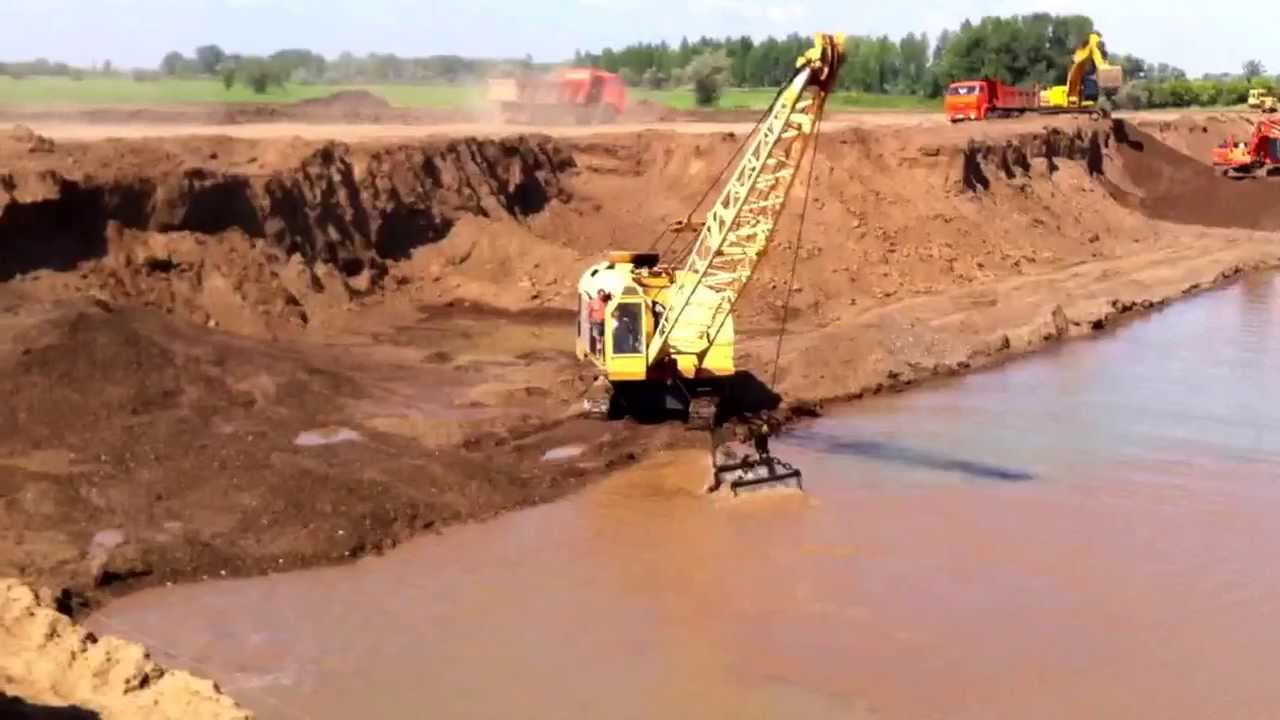
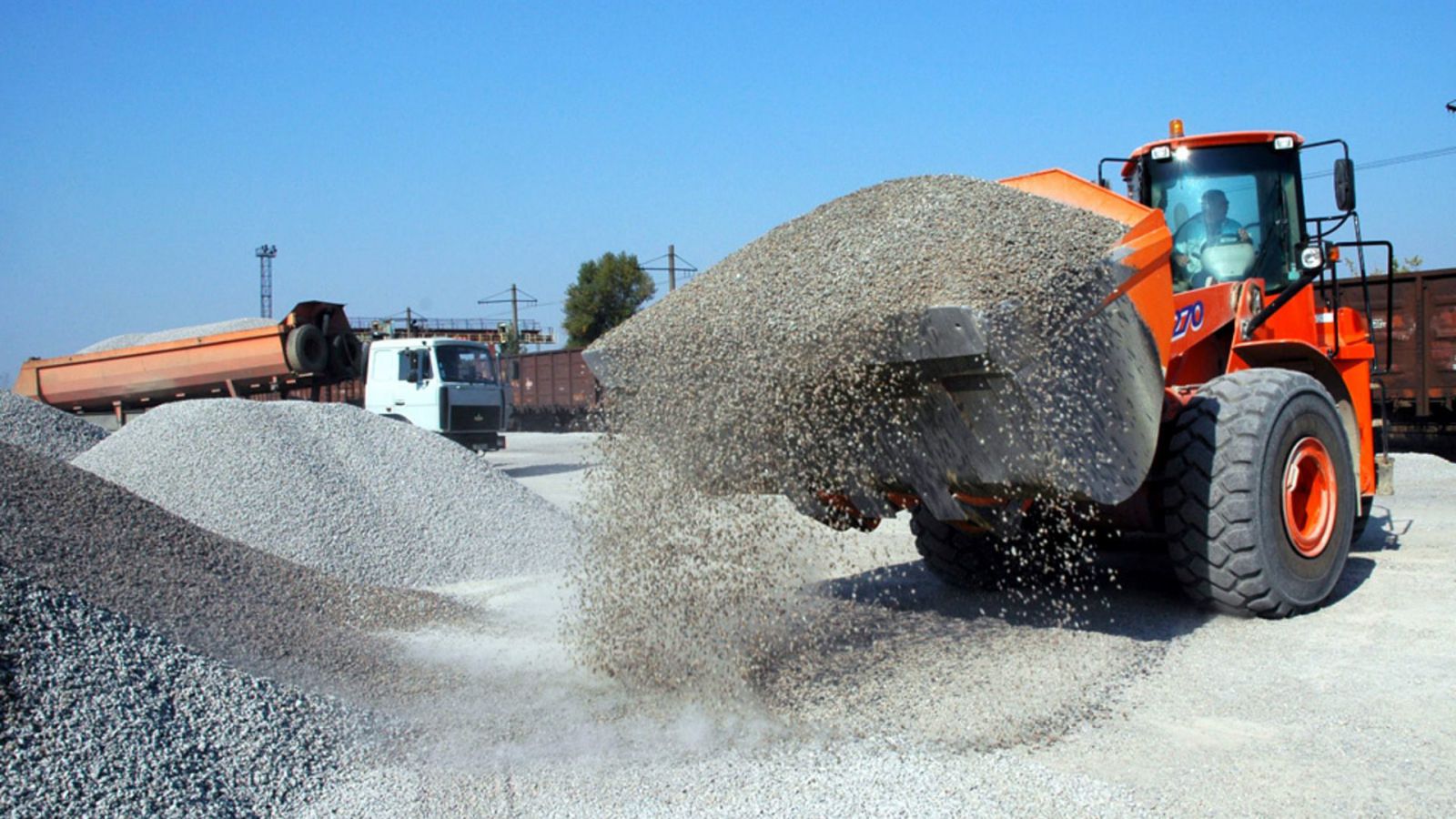

Email
Phone number
Connection will be made via internet - no charges apply. Microphone access required.
Adding to Favorites
Your comment:

